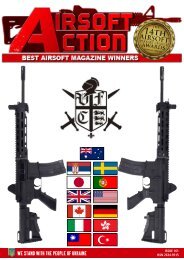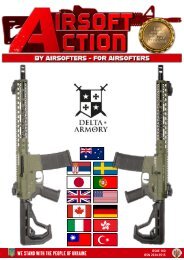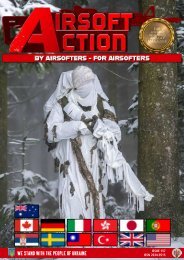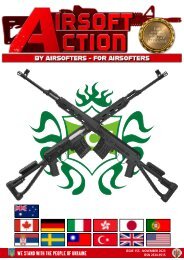PMCI - June 2019
PMCI continues its coverage of the 2019 "show season" as Bill lands his annual report from IWA in Nuremberg; there's also coverage of the latest from Spartan Blades, an in depth look at the Laser Ammo Training System, and Clint returns to his service days, getting on the range with the Mossberg 590A1! As usual, if it's tactical and worth knowing about you'll find it in PMCI.
PMCI continues its coverage of the 2019 "show season" as Bill lands his annual report from IWA in Nuremberg; there's also coverage of the latest from Spartan Blades, an in depth look at the Laser Ammo Training System, and Clint returns to his service days, getting on the range with the Mossberg 590A1! As usual, if it's tactical and worth knowing about you'll find it in PMCI.
You also want an ePaper? Increase the reach of your titles
YUMPU automatically turns print PDFs into web optimized ePapers that Google loves.
pmcimagazine.com<br />
<strong>PMCI</strong><br />
BOOK REVIEW<br />
MASTERS OF MAYHEM:<br />
LAWRENCE OF ARABIA AND<br />
THE BRITISH MILITARY MISSION<br />
TO THE HEJAZ<br />
BOOK REVIEW<br />
Every so often you stumble across a book purely by accident that<br />
turns out to be that absolute gem that you can’t work out why<br />
you’ve never read before! At a recent event I happened to run<br />
into Connor from Casemate Publishing and whilst chatting to him<br />
a new title offered by them really caught my eye.<br />
In fairness it was the combination of the striking cover image<br />
of Rolls Royce armoured cars accompanied by the tagline “The<br />
Seeds of British Special Operations” that really piqued my curiosity.<br />
Like many of you I have read and studied “The Seven Pillars<br />
of Wisdom” (the autobiographical account of the experiences of<br />
British soldier T. E. Lawrence while serving as a liaison officer with<br />
rebel forces during the Arab Revolt against the Ottoman Turks of<br />
1916 to 1918), but “Masters of Mayhem” looked to be chock<br />
full of more information on a very specific part of “Lawrence of<br />
Arabia’s” war, and I was not to be disappointed.<br />
Strike where the enemy is weakest and melt away into the<br />
darkness before he can react. Never confronting a stronger force<br />
directly, but willing to use audacity and surprise to confound and<br />
demoralize an opponent. Operations driven by good intelligence,<br />
area knowledge, mobility, speed, firepower, and detailed planning<br />
and executed by a few specialists with indigenous warriors - this<br />
is unconventional warfare. T. E. Lawrence was one of the earliest<br />
practitioners of modern unconventional warfare. His tactics and<br />
strategies were used by men like Mao and Giap in their wars of<br />
liberation. Both kept Lawrence’s “Seven Pillars of Wisdom” close<br />
at hand.<br />
“Masters of Mayhem” however looks in depth at the creation<br />
of the HEDGEHOG force, the formation of armoured car sections<br />
and other units, and focuses the Hejaz Operations Staff, the Allied<br />
officers and men who took Lawrence’s idea and prosecuted it<br />
against the Ottoman Turkish army assisting Field Marshal Allenby<br />
to achieve victory in 1918. Lawrence states in his “27 Articles”<br />
(his classic set of guidelines on military leadership in the Middle<br />
East) that “The Hejaz confounds ordinary tactics” and “Masters”<br />
goes some way to provide an understanding of why this was and<br />
how the Allied forces at the time set about developing a new<br />
style of warfare to cope with it.<br />
James Stejskal is a former US Army Special Forces soldier<br />
who served on special operations in many “interesting places”<br />
worldwide before retiring as a Chief Warrant Officer 4. He was then<br />
recruited by the Central Intelligence Agency to serve again as a<br />
senior Case Officer in<br />
Africa, Europe, and<br />
the Far East before<br />
finally retiring from<br />
active service and<br />
this background<br />
really shows in his<br />
understanding of the<br />
place, the conditions<br />
encountered, the<br />
men, and the tactics.<br />
Do not expect<br />
a dry account of<br />
simply “who did<br />
what, to whom,<br />
when, and with<br />
what” but instead<br />
journey into the<br />
hearts and minds<br />
of the soldiers on<br />
the ground who<br />
unknowingly really did set the seeds for what we know now as<br />
Combined Arms Operations, integrating different combat arms to<br />
achieve mutually complementary effects on the battle space.<br />
I have to say that I found “Masters” to be an utterly fascinating<br />
read from start to finish, even learning more of the “geo-politik”<br />
of the region along the way, and Stejskal concludes with an<br />
examination of how HEDGEHOG influenced special operations<br />
and unconventional warfare, including Field Marshal Wavell, the<br />
Long Range Desert Group, and David Stirling’s SAS!<br />
If you truly desire to look at how “thinking outside the box”<br />
worked in a very practical way, and led to some of the tactical<br />
concepts we hold as gospel today, then reading this gripping book<br />
is a must!<br />
Author: James Stejskal<br />
Hardcover: 304 pages with numerous photographs and<br />
maps<br />
Publisher: Casemate Publishers<br />
Language: English<br />
ISBN-10: 1612005748<br />
44


















